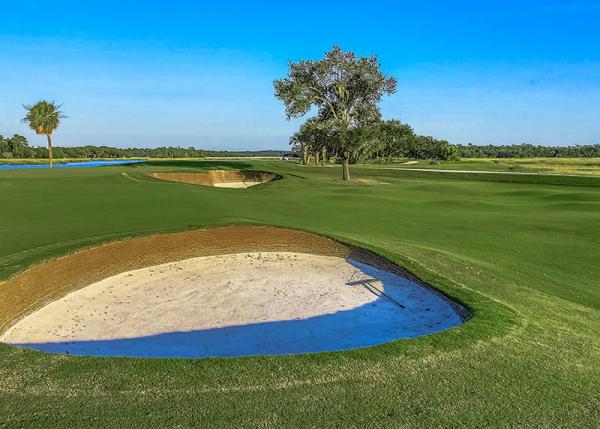When Keith Ihms wanted to introduce Scottish-style bunkers to golfers in Arkansas, naturally, he turned to synthetic sports turf for a long-lasting solution.
 Ihms, director of golf course maintenance at Bella Vista, a six-course property in northwestern Arkansas, became a fan of revetted bunkers during his travels abroad as president of the GCSAA in 2014. When it was time for a renovation of Bella Vista's Scottsdale course, he wanted to introduce the concept to golfers there, but there was one teeny little problem. Although natural sod walls can last for years in Scotland's temperate climate, they tend to fail prematurely under hot, humid summers in Arkansas and elsewhere throughout the United States.
Ihms, director of golf course maintenance at Bella Vista, a six-course property in northwestern Arkansas, became a fan of revetted bunkers during his travels abroad as president of the GCSAA in 2014. When it was time for a renovation of Bella Vista's Scottsdale course, he wanted to introduce the concept to golfers there, but there was one teeny little problem. Although natural sod walls can last for years in Scotland's temperate climate, they tend to fail prematurely under hot, humid summers in Arkansas and elsewhere throughout the United States.During the past few years, Ihms had become familiar with the PermaEdge system that creates stable, revetted bunkers faces through a system of used used synthetic turf tiles stacked atop one another.
"When this project if finished, I don't think we will have to redo our bunkers any time soon," Ihms said.
Developed by Richard Allen, a civil engineer and avid golfer from Wales, the PermaEdge system incorporates square tiles of repurposed synthetic turf that are filled with sand and when stacked one on top of the other can create a sturdy bunker face that will resist erosion and should last for 20 years or more, the company says. It is available in North America exclusively through IVI Golf, maker of the Sandtrapper bunker liner system.
Tiles that have been prepared to meet PermaEdge specifications come in two widths, 8 inches and 4 inches. At Bella Vista, Ihms cut in 12 inches from the bunker face, stacked two tiles on the floor, went back one finger's width and stacked two more. He repeated the process until a bunker 2.5-feet thick was completed, and has plans to install up to 11 more as the bunkers play an integral role in Ihms' Scottish-themed renovation of this 1987 Edmund Ault design that is due to be completed later this month.
The installation process includes starting on a level base, backfilling the area with clean fill, topsoil and Portland cement to help stabilize the wall. Because golfers see the tiles from the side rather than from the top down, the exposure of synthetic turf is minimal.
"When the turf is green, it doesn't look artificial at all," Ihms said. "When the grass goes dormant, there will still be a green tint there, but you're looking at it from the side and each piece is filled with sand. It's not going to be an issue.
"This is not just Astroturf thrown down. This is not that look at all."
Golf course architect David Whelchel is a member at Bella Vista and has consulted with Ihms on the project, that includes the Billy Bunker liner system.
"Because of the hotter summers here, microbial action causes sod bunker walls to deteriorate more quickly," Whelchel said. "Sod has thatch in, and once that microbial action begins it just disappears. You can lose a foot or two in just three years."

